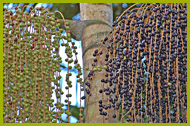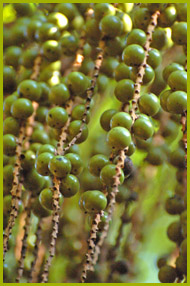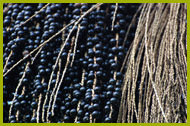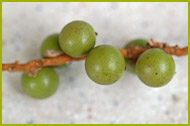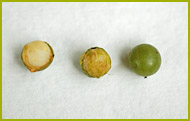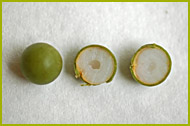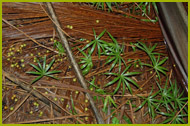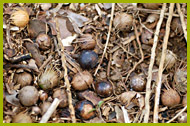|
|
|
|
|
|
Fruits
|
|
|
|
|
|
Globose drupe with 1 to 1.4 cm in diameter composed of a smooth, thin epicarp (skin) with a first green than light-dark purple to black colour at maturity and a sparely, fibrous, carnose mesocarp (pulp) enclosing a single seed (HENDERSON 2000, QUEIROZ 2000). In average a plant produces 3 bunches of fruits, with different times of maturation. E. edulis starts to produce fruits after 8 to 15 years. Each plant produces 1-5 fruit infructescences annually, each of which bears over 3000 fruits.
According to local variations fructification begins in May and its maturation takes place until November (MATTOS & MATTOS 1976, GALETTI et al. 1999, FISCH et al. 2000). This broad period of fructification ensures the food supply for wildlife.
|
|
|
|
Seeds
|
|
|
|
|
|
Almost spherical, grey brown to yellowish-brown, surrounded by a fibrous coverage, with up to 10 mm in diameter. Seeds of this species have a very abundant and non-fissured endosperm (QUEIROZ 2000), with high levels of reserves, composed of carbohydrates (about 88%), proteins (10%) and lipids (2%) (REIS 1995).
|
|
|
|
|

|
|
|
|
Reproduction
|
|
|
|
|
|
The flowers are visited by many insects, collecting nectar and / or pollen and at the same time promote pollination. Bees, wasps and flies are frequent and collect indistinctive nectar in male and female flowers, playing an important role in pollination, while visiting beetles prefer male flowers, consuming flower pollen and parts of the flower. Despite being a species pollinated by insects (zoophilia), in case of higher plants the wind may play a role as pollinator (anemophily). For the occurrence of cross-pollination, when there is an overlap of male and female phase between 2 or more inflorescences of the same plant, strategies exist rendering possible self pollination (MANTOVANI & MORELLATO 2000). Approximately 50% of the inflorescences form fruits, in each of it the amount varies around 3000. The fruits maturate from 165 to 270 days after fecundation (MANTOVANI & MORELLATO 2000).
Dispersion of the fruits occurs through animals (zoochory) (REIS & KAGEYAMA 2000). The carnose fruit pulp attracts a large number of birds as toucans, macaws, parrots, thrushes, tinamous, guans and tanagers, arboreal and terrestrial mammals as opossums, bats, deer, tapirs, rodents and primates, as well as reptiles (lizards) and ants that act as dispersers of seeds (QUEIROZ 2000).
Studies in a region of the Mata Atlântica in Santa Catarina have estimated an average production of 38 fruits per sq metre, from which 5.31 seeds per sq metre are found in the soil (14%) and only 45% of them are in good condition. In this study area the obtained proportion was 377 fruits produced by each plant that reaches adulthood (REIS & KAGEYAMA 2000). The mortality, in terms of natural regeneration, is 80 to 86% after 5 to 6 years of plant age, caused by herbivores, diseases, intra- and insite-specific competition such as unfavourable microclimate (CONTE et al. 2000).
E. edulis is characterized as a kind of plant that does not reproduce vegetative, but forms a dense bank of seedlings with spatial distribution, grouped near the parent plant, waiting for adequate lighting to develop (REIS et al. 1996, FANTINI et al. 2000, QUEIROZ 2000). The seed fall is concentrated on the next mother plant registered with distances of 52 and 61 meters (SÁ-ROCHA et al. 2002). In distinct populations of Santa Catarina and São Paulo, high genetic diversity could be observed with an excess of heterozygote (hybrid) (REIS et al. 2000b).
|
|
|
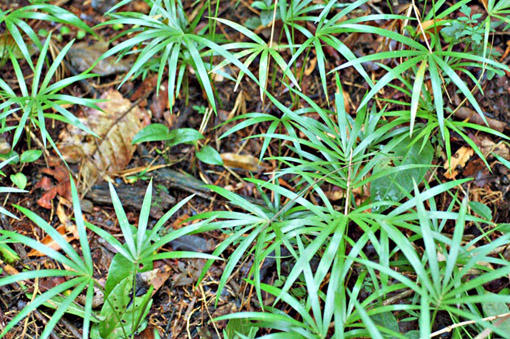 |
|
|
|
Bank of seedlings
|
|
|
|
|
|
|

